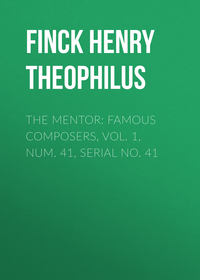Kitap dosya olarak indirilemez ancak uygulamamız üzerinden veya online olarak web sitemizden okunabilir.
Kitabı oku: «The Mentor: Famous Composers, Vol. 1, Num. 41, Serial No. 41», sayfa 3
LISZT, THE MANY-SIDED
Richard Wagner called Liszt “the greatest musician of all the ages.” He certainly was the greatest pianist of them all, unequaled to this day; but he was very much more than that. In all departments of music, except the opera and chamber music, he created a new epoch or opened new and glorious vistas; and his influence on the musicians of his time and those who came after him was as great as Wagner’s.
The strangest thing in Liszt’s extraordinary career is that when he was at the height of his fame as a pianist, and fabulous sums were offered him for recitals, he renounced his instrument, so far as concerts were concerned. For charity he would play occasionally, and for his friends and his pupils; but not for the paying public. This happened thirty-nine years before he died.
Various motives prompted this action, one of them being that he preferred creative work. Thus it came about that the loss of his contemporaries in not hearing him play was our gain in enabling us to hear his songs, his piano pieces, his choral and orchestral compositions. Many of these are still “music of the future”; but their day is dawning.
At piano recitals, in America as in Europe, no composer’s pieces are now more favored than Liszt’s. Pianists usually place them at the end of the program; not only because they make a brilliant close, but because they prevent the audience from leaving before the end, as few or none want to miss these pieces.
THE DYNAMIC EFFECTS OF LISZT
The reasons why the public is so enamoured of Liszt are not far to seek. While Chopin is, as Rubinstein called him, “the soul of the pianoforte,” because he makes it speak its own language as no one had made it speak before, Liszt’s piano music is no less idiomatic, and at the same time it is even richer in color and more varied in tonal power, or what musicians call “dynamic effects.” Not satisfied with the piano as such, Liszt converted it into a miniature orchestra, enabling the pianist to thunder or to whisper in tones not previously heard from that instrument.
Much of Liszt’s music, for both piano and orchestra, is program music: it tells its story in tones. In “St. Francis Walking on the Waves” one actually hears the waters, as in the orchestral “Mazeppa” one hears the galloping of the wild steed and the groans of the man tied on its back. The public likes music with such pictorial associations; but it would never have taken to Liszt’s program music as it has were it not at the same time good as music pure and simple,—interesting melodically, rhythmically, and harmonically.
Musicians, as well as the public, admire in Liszt’s orchestral works the same variety of new colors that enrich his piano music. They honor him for having created new forms of music in his symphonic poems, differing from symphonies as Wagner’s music-dramas differ from opera.
What the public likes best of all in Liszt’s works, however, is his Hungarian rhapsodies, in which the gipsy songs of love and war and every phase of life are “pianized” with marvelous art, one of the greatest charms of which is that it is absolutely unfettered and unconventional,—a real improvisation, like the playing of gipsies themselves.
BRAHMS, THE CONSERVATIVE
Admirers of Liszt, and full-blooded Wagnerites, rarely care much for Brahms; while, conversely, the Brahmites look somewhat haughtily on those two composers, and all the other “progressives,” except Schumann, who is exempted, not only because there is a certain affinity between his music and that of their idol, but because he discovered Brahms, proclaiming him the “musical Messiah.” Brahms himself once signed a “protest” aimed against the Wagner-Liszt school; yet his bark was worse than his bite, for his works here and there show the influence of Wagner, and he liked some of Wagner’s operas.
Johannes Brahms is the god of the conservatives. He aimed, half-consciously, to carry on the traditions of Beethoven, and he had no use for modern realism and program music. His symphonies—the most delightful of which is the second—are marked simply numbers one, two, three, and four; and for his piano pieces he has no poetic titles after the manner of Schumann: they make their appeal by their own beauty, unadorned—and they have won a large audience of admirers.
Some of his songs everybody likes. They are on most programs, and are often redemanded. The music goes well with the words, and they are usually written most effectively for the voice, which makes the singers favor them too. But it is in his chamber music—trios, quartets, or sextets, for strings, with or without piano—that Brahms’ genius is most convincing. In this department he has composed many masterworks.
In general, it may be said that, while Brahms is melodically less spontaneous than some of the other masters, he excels most of them in the variety and originality of his rhythms.
